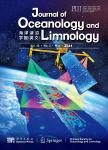Distribution of chromophytic phytoplankton in the Western Subarctic Gyre of Pacific Ocean revealed by morphological observation and rbc L gene sequences
作者机构:School of OceanYantai UniversityYantai 264005China Key Laboratory of Sustainable Development of Marine FisheriesMinistry of AgricultureYellow Sea Fisheries Research InstituteChinese Academy of Fishery SciencesQingdao 266071China Key Laboratory of Ministry of Education for Environment Change and Resources Use in Beibu GulfGuangxi Key Laboratory of Earth Surface Processes and Intelligent SimulationNanning Normal UniversityNanning 530001China State Key Laboratory of AcousticsInstitute of AcousticsChinese Academy of SciencesBeijing 100190China School of MedicineYunnan UniversityKunming 650091China College of Ocean and MeteorologyGuangdong Ocean UniversityZhanjiang 524088China
出 版 物:《Journal of Oceanology and Limnology》 (海洋湖沼学报(英文))
年 卷 期:2023年第41卷第6期
页 面:2166-2179页
核心收录:
学科分类:0710[理学-生物学] 07[理学] 0707[理学-海洋科学] 071004[理学-水生生物学]
基 金:Supported by the National Key Research and Development Program of China(No.2019YFD0901401) the National Natural Science Foundation of China(Nos.42176206,81900630) the Natural Science Foundation of Shandong Province(No.ZR2021MD071) the“One Hundred Talents”Project of Guangxi(No.6020303891251) the Outstanding Youth Project of Yunnan Provincial Department of Science and Technology(No.2019F1019)。
主 题:flow cytometry microscopic counting phytoplankton rbc L Western Subarctic Gyre
摘 要:Western Subarctic Gyre(WSG),which possesses distinctive differences in oceanographic and biogeochemical processes,is situated in the northwest subarctic Pacific.The WSG is characterized by high nutrient and low chlorophyll.We carried out a field investigation in this area in summer 2020 and performed microscopic observation,cytometric counting,and RuBisCO large subunit(rbc L)gene analysis to understand the community structure and spatial distribution of chromophytic phytoplankton better.Microscopic method revealed that total phytoplankton(10μm,including Bacillariophyta,Dinoflagellata,Ochrophyta,and Chlorophyta)abundances ranged(0.6×10^(3))-(167.4×10^(3))cells/L with an increasing trend from south to north.Dinoflagellates and Pennatae diatoms dominated the phytoplankton assemblages in the southern and northern stations,respectively.Major chromophytic phytoplankton groups derived from rbc L genes included Haptophyta,Ochrophyta,Bacillariophyta,as well as rarely occurring groups,such as Xanthophyta,Cyanobacteria,Dinoflagellata,Rhodophyta,and Cryptophyta.At the phylum level,Haptophyta was the most abundant phylum,accounting for approximately 30.80%of the total obtained operational taxonomic units in all samples.Ochrophyta and Bacillariophyta were the second and third most abundant phylum,and their relative abundance was 20.26% and 19.60%,respectively.Further,redundancy analysis showed that high proportion of diatoms(e.g.,microscopic and rbc L methods)was positively correlated with nutrients(e.g.,dissolved inorganic nitrogen(DIN),dissolved inorganic phosphorous,and dissolved silicate(DSi))and negatively correlated with temperature and salinity.The proportion of Ochrophyta,Rhodophyta,and Cyanobateria identified by rbc L genes was positively correlated with salinity and temperature and showed negative correlation to nutrients.This work is the first molecular study of phytoplankton accomplished in the WSG,and our results show some discrepancies between morphological observation and rbc L gene sequences,which highlight the necessity of combining the microscopic and molecular methods to reveal the diversity of phytoplankton in marine environment.



